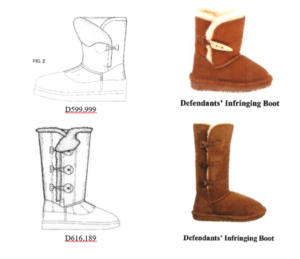Utility patent applications cover the way an invention function while design patent applications cover the way an invention looks. Many of our clients are candidates for both utility and design applications (often for the same invention). For example, one of our clients is an inventor of a percussive instrument producing cymatic effects. The invention uses water to alter the sound of the drum. We protected the function of the drum with a utility patent (US 10,621,960). Theoretically, the drum could have many different shapes and still function the same. However, the particular drum this inventor brought to market had a specific (and good-looking) design. That specific design was protected with a design patent (D858,626).
When forming an invention protection strategy we often include design patent applications as building blocks for patent portfolios. Unfortunately, many clients have heard that a product design only needs to be ever-so-slightly changed to “get around” an issued design patent. The truth is, small changes to a product design may not overcome an infringement claim and, as such, design patents offer significantly more protection than many realize. Set forth in the “ordinary observer test,” of Egyptian Goddess, Inc. v. Swisa, Inc., 543 F.3d 665 (Fed. Cir. 2008), a design patent is infringed if the accused article is “substantially the same” as the claimed design in light of the prior art, from the perspective of an ordinary observer (who is a purchaser of the type of goods accused of infringement).
As one may imagine, the “ordinary observer test” inquiry as to whether products are “substantially the same” is often difficult to determine. This ambiguity makes it difficult to form a definitive opinion that a design is not “substantially similar” to a patented design. For design patent holders, this ambiguity may be a hurdle for competitors. Of course, the more hurdles we can put before our competition the better. For example, a jury considered whether the brown boots pictured below infringed the design patents shown in the black and white figures. As you can see, there are many differences between the shoes and they are certainly not identical. Still, a jury found that the boot designs were substantially similar, and thus the Defendant infringed the granted design patents.
Deckers Outdoor Corp. v. Romeo & Juliette, Inc., Case No. CV 15-02812 (C.D. Cal. Aug. 10, 2018)
The above finding of design patent infringement illustrates the risk associated with creating products “similar” to those depicted in granted design patents. Whether a cause of action for design patent infringement is successful will depend on a jury’s view of whether an ordinary observer would believe the products are substantially similar. Companies creating new designs should seriously consider ongoing design patent filings to protect the ornamental aspects which provide competitive advantages. While utility patents are infringed if the words of the claims are read on another product (claim construction), design patents are infringed if an ordinary observer would find the two designs are substantially similar. We recommend our clients take advantage of these different standards of review whenever possible.
If you need further assistance contact us today. We serve clients throughout Alabama including Mobile, Huntsville, and Birmingham.


